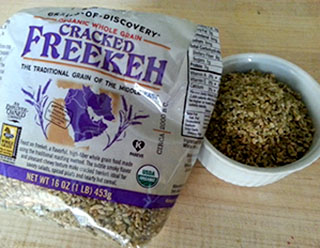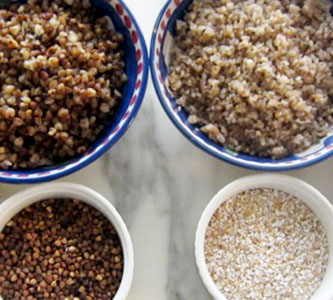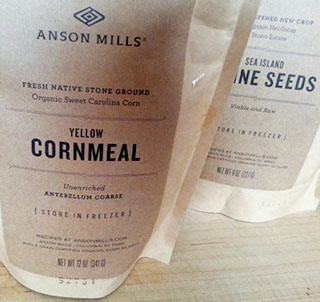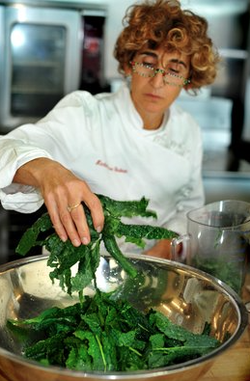Chefs are coming up with all sorts of inspiring ideas for grains, and I was lucky enough to learn about some of them when I moderated a panel of three local chefs, Ana Sortun of Oleana and Sarma, Jason Bond of Bondir, and Barry Maiden of Hungry Mother, as well as Liz l’Etoile of Four Star Farms, a small Massachusetts farm that is producing and milling wheat, corn, rye, barley and hops. I was inspired to revisit teff, a tiny grain that is a staple in Ethiopia (they use it for their fermented injeera bread). I’ve never had much luck with teff, but when Jason Bond described the polenta he makes and seasons with chipotle, I was ready to give it a try. I also had a breakthrough with farrotto (farro risotto), because Barry Maiden told me to first soak the grains and crack them in a food processor. The farrottos I subsequently made were creamy, like a risotto should be, and I’m looking forward to using this method with other robust grains as well, like barley and spelt.
One of the new old grains that has peaked my interest since the conference is freekeh, a green wheat product that is popular throughout the Middle East but seems to be just catching on here. It has a smoky/earthy flavor that has won me over, the result of the production process: the immature grains of durum wheat are harvested just when the leaves begin to yellow and the seeds are still at the soft, creamy stage. The wheat is arranged in small piles, left to dry for a day, then the piles are set on fire and the flames carefully controlled so that only the straw and chaff burn. The moisture of the seeds prevents them from burning, but they do take on a marvelous smoky flavor and aroma. The wheat then undergoes further thrashing, or rubbing (the name comes from the Arabic word farik, which means “rubbed”) and drying, and then the grains are cracked, so that it looks a bit like coarse bulgur, but the color is greener and darker.
Barry Maiden also talked about the amazing grits and cornmeal milled from heirloom varieties of corn by Anson Mills, and one of the first things I did when I got home was place a big order so I could find out what he was talking about. The grits were simply life-changing. I cooked them according to the very specific Anson Mills recipe by creative director Kay Rentschler, and I can assure you, they are the most luxuriously flavored grits you will ever taste. When properly cooked – over very low heat after an overnight soak – the resulting grits are incredibly creamy and almost as sweet as fresh corn. They are nothing like the boring white grits I’ve had in the past that no amount of butter or salt can remedy.
I also revisited kasha, the cooked cereal made with buckwheat groats. I’d given up on this grain for a while, as I my results were not consistent when I cooked the groats; they would sometimes come out mushy and indistinct. But this changed when I bought a box of Wolff’s medium-cut kasha at the supermarket, followed the directions on the box, and ended up with a perfect batch of nutty, fluffy kasha.
So, don’t let the dearth of winter vegetables get you down this season as you try to stay warm. Experiment with whole grains, use them in big bowls, substituting them for some of the grains I call for in my Craftsy class big bowls, or make up your own dishes, and I can assure you, you’ll have an exciting winter in your kitchen.




 RSS Feed
RSS Feed
